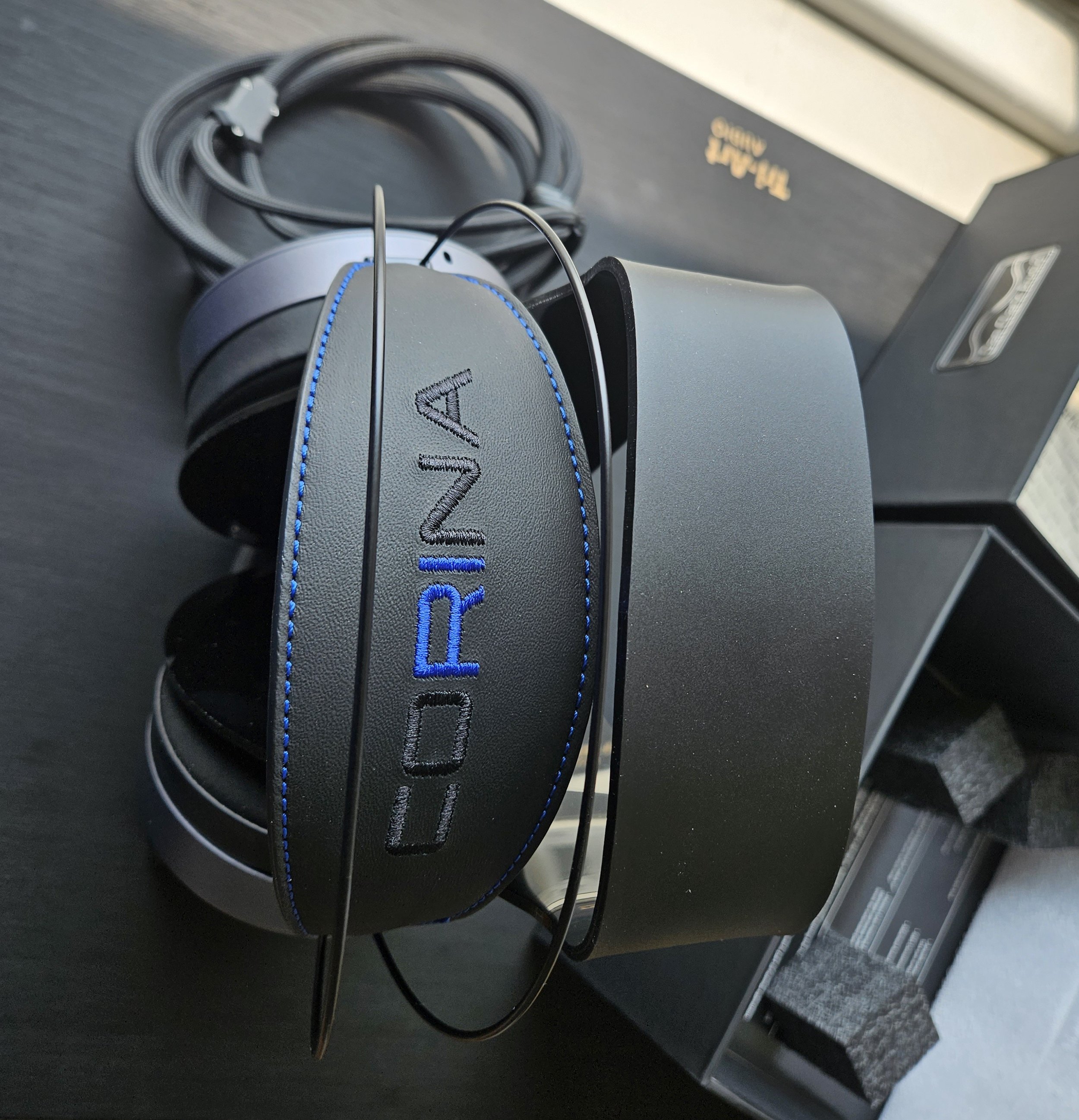THE DAN CLARK CORINA - REVIEW
THE DAN CLARK CORINA
It is alway great fun for me to travel to the world of electrostatic components—headphones, amplifiers, speakers—via my ever evolving Tardis—now a Mid Century Modern, beautifully upholstered chair (& a half). Indeed, electrostatics provide musical insight into another world, entirely. It is a world removed from dynamic headphones and planar magnetic headphones and encompasses a vast network of lands—STAX, VIVA, HeadAmp, Trilogy, Dan Clark, Warwick Acoustics, Martin Logan, Quad, etc. Perhaps this is why after so many decades electrostatics are alive, well, and thriving!
It’s over two and a half years now since I made my first trip to this planet via my then Yellow-Chair-Tardis, a time and space machine of sorts, when coupled with electrostatic ‘engines’. And on that first trip I discovered that it was possible to move beyond musical simulacrum—a very good high fidelity rendering of one’s music—to an experience that could almost literally place one in the relevant performance venue. How is that possible?
There is something about electrostatics that masterfully recreates the ambiance, the air, meticulous soundstaging—depth, breadth, layers, position, and space between performers—and then the various microdynamics—small tell-tale signs of a given venue—that allow for one’s easy suspension of disbelief. And, as a direct result, you are there with the performer(s), comfortably ensconced in venue—the nightclub, the concert hall, the arena, etc.—and upon your own purposed Tardis.
“Humbug!” You say. Then it is an experience that you’ll be needing to have for your own confirmation. And I, for one, am happy to suggest the travel arrangements via the various electrostatic gear, as I imagine would Justin Wilson of HeadAmp (a truly good guy). You, however, will have to provide your most comfortable chair, as Tardis—time and space machine—to make this journey to the Electrostatic World.
I travel to the Electrostatic World this time with a well known and superb electrostatic engine/amplifier—the HeadAmp Blue Hawaii Special Edition (BHSE)—and a multi-award-winning DAC/Streamer—the Mola Mola Tambaqui—and, for the first time, Dan Clark’s latest electrostatic headphone, the CORINA, the subject of this review. Other components in the review—Mojo Audio Mystique SE DAC, Silent Angel Bonn N8 Pro network switch, Audience FrontRow, and AntiCable wires and cables, and the TORUS RM20 power conditioner.
REFRAIN: Unlike most reviews, this review will be non-sequential, as it will start with how the components actually sound and not the process of physically “undressing” them and/or laying out their various parts, specifications, etc. Think of this review then, as a non-linear movie—Memento, Kill Bill, Arrival, Eternal Sunshine of the Spotless Mind, Transcendence, etc—that, likewise, starts at the end and winds its way to the beginning.
The Sound
If ever a component could itself be called ‘musical,’ then the Dan Clark CORINA is that component, are those headphones. And this will be self-evident to, dare I say, anyone who dons these headphones and plays an album, a CD, or a stream. There is simply no other way around it. If you are, indeed, a music lover first, then the CORINA will lure you in, immerse you in the music in a manner so few components of any type can do.
As mentioned above, the earmarks of the venue are beautifully brought together via the CORINA like few headphones have any right or ability to do. The palpability of a given soundstage, the performer(s) therein, and the various ambient cues are simply outstanding. I am forced, constantly, to stop and appreciate what I’ve just heard as it relates to a given performance. This is rather inefficient for a reviewer but tremendously informative for a lover of music.
Tone, timbre, and the texture of instruments are so incredibly natural, so lifelike as to render the performance of other headphones mere facsimiles of the selfsame performance. Further, the CORINA is, perhaps, one of if not the most natural electrostatic headphone that I have yet reviewed. Its only current rival in this respect is the STAX SR-X9000 ($6,200).
In terms of the CORINA’s transparency, its resolution, and its ability to unveil previously hidden details, it gives nothing away to the STAX SR-009S ($4,500) electrostatic headphone. And the CORINA is inherently more musical and, again, more natural than the SR-009S. The CORINA and the STAX SR-X9000, STAX’s Top-of-the-Line (TOTL) electrostatic headphone, are a good deal more alike than different and may well be on the very same performance plane.
The controversial Tommy Flanagan album Solo Piano plays through and it is sublime and goes by far too quickly. It is controversial in that Tommy Flanagan is said not to be the actual pianist for the majority of the tracks across the album. And Storyville, the album’s producer, was said to have removed Solo Piano from its catalog as a result. Yikes! Can you imagine a more profound blunder? However, the music is sublime nonetheless via the assembled system and the CORINA electrostatic headphone.
The Dan Clark CORINA’s soundstage—its volumetric cube—is vast, holographic, and extremely adaptive to venue, wherein it can accommodate, beautifully, the intimate solo, duo, or trio performance and it can also accommodate the tumult of larger driving symphonies or of stadium concerts. In this respect, it is eminently adaptable. Its staging abilities—layering, position, relative space, image stability—of performances is extraordinary and, at times, it will appear as though the sound is coming from somewhere in your listening room and not through the headphones. Electrostatics do indeed have an ability to excel beyond other headphone technologies in this respect, though the CORINA carries things a bit further still. The CORINA moves far beyond its electrostatic sibling, the VOCE, and even places great distance between itself and the STEALTH—a planar magnetic headphone—which I had found to be “incredibly natural, immersive, and very refined.”
THE SYSTEM(s)
SYSTEM 1
Baetis Audio Revolution X4 Streamer
Silent Angel Rhein Z1 Plus Streamer
Silent Angel Forester F2 LPS
Silent Angel Bonn N8 Pro Network Switch
Mola Mola Tambaqui DAC
Mojo Audio Mystique X DAC
HeadAmp Blue Hawaii SE Electrostatic HPA
Dan Clark VOCE Electrostatic Headphones
STAX SR-009S Electrostatic Headphones
AntiCable, Audience, RSX Cables & Wires
Shakti Stone Airs & Online Airs EMI
TORUS RM20 Power Conditioner
BASS
Tight. Resolute. Focused. I do not think that there is another electrostatic headphone that is as effective or competent at rendering the bass frequency region as is the Dan Clark CORINA. Yes, in retrospect, not even the STAX SR-X9000 was as tight or resolute or transparent in the bass region, despite its profound abilities.
The assuredness of the CORINA’s bass rendering capabilities is truly remarkable, as when listening to bass-rich or bass-infused recordings, I am momentarily at a loss to recall if I am still/actually listening to an electrostatic headphone. With other electrostatic headphones, I can wish for this, but wishing does not make it so.
Eiji Oue’s “V. Infernal Dance of King Kashchey” (Stravinsky, Reference Recording) is a litmus test for me, despite the fact that its overall recording volume is stepped down and must be adjusted for playback relative to all other music. That said and when readjusted for playback via the BHSE, the CORINA broaches beautifully the sub-bass strata, like few electrostatic headphones can. In truth, few headphones across the technological designations—electrostatic, planar, dynamic—can plumb these depths. The CORINA, nonetheless, does an exceptional job, and on other better recorded faire, the ‘Holy-Bass-Head-Grail’ is closer still. And it does this all with a naturalness and refinement that is incredibly immersive and addictive. The CORINA handles this track beautifully and then a host of others—David Holland’s “B-40/M23-6K/RS-W” (Emerald Tears, ECM) and its deft bass surgery, Massive Attacks’ “Angel” (Mezzanine, Circa) with its throbbing, rhythmic bass, Marcus Miller’s “Power” (M2, Concord) with its resolute, driving bass line—all with consummate ease.
Midrange
There is no other headphone medium/technology that renders choral or live music or its meticulous layering of the soundstage like electrostatics. I listen to choral and live music and heavily layered music—symphonies—primarily with electrostatics for the experience, the pleasure, the discovery. The CORINA is phenomenal in this respect while providing the ambiance and air, and the interaction of the music with the hall.
There is a transparency via the CORINA which allows one to hear, literally, everything across “Agnus Dei” (Enchanted Isle, Decca), as it provides the various micro-details, orphaned with other headphones, with a ‘voice’ that makes them germane and clearly part of the piece. The STAX SR-X9000 and the SR-009S are certainly capable of providing ‘voice’ to the micro-details as is the Abyss AB1266 Phi TC, the only non-electrostatic headphone so capable. The CORINA however, in this respect, challenges them all.
Andy Bey’s voice is a blend that age and experience have honed to a graveled texture and substance, which can often cause its playback to be problematic—bloated, unrefined, opaque. On “Angel Eyes” (American Song, Savoy) via the Dan Clark CORINA Andy’s voice is natural, refined, transparent and resolved, superb! I go on memory now of the STAX SR-X9000 which gave a like rendering. The STAX SR-009S, however, which sits beside the BHSE, cannot match this rendering, cannot provide the naturalness of his voice. Not like the CORINA.
TREBLE+
In truth, Dan Clark’s VOCE was, well, a bit acrophobic—shy of heights—when it came to the treble and could not keep up with the various STAX headphones. Though the VOCE’s midrange was more than a match for the various STAX with the exception of the SR-X9000. The CORINA suffers no similar treble limitations or treble-acrophobia as did its sibling. And in terms of naturalness and musicality it can match the STAX SR-X9000!
Dave Brubeck’s “Take Five” (Time Out) is a perennial favorite when it comes to ferreting out those components able to both parse and resolve treble energy in the form of drum cymbals—Joe Morello’s drum cymbals. As “Take Five” plays through it is energetic and delicate as the tip-top treble notes are easily parsed, natural, and beautifully resolved via the CORINA. This is, no doubt, a direct consequence of the CORINA’s superb microdynamics, its rendering of ambiance and air. As I have often commented regarding lesser gear—“this is not bacon frying or some other edible sizzling away on too hot a skillet, in lieu of well resolved high-treble notes.” No. This is the natural reproduction of those tip-top treble notes beautifully executed.
Hilary Hahn’s Sonata No. 1 in G minor: Adagio (Bach: Violin Sonatas Nos 1 & 2; Partita No. 1, Decca) plays through and the tone and timbre of the notes are rich, textured, extended, and its transients hypersonic. This, the speed, of course is the domain of electrostatics—headphones, speakers—and cannot be matched by any other technology. All in all, the CORINA has indeed come very close to matching the STAX SR-X9000. Some may well even choose the CORINA for its greater overall musicality and its immersiveness relative to the STAX SR-X9000.
The Wrappings and Accessories
The Dan Clark CORINA headphones come in a thick, black, rectangular, cardboard box, minimally printed—the CORINA logo on its top face, the Dan Clark logo on a side face, directly beneath the CORINA logo.
Taking the box’s top off gives way to a black interior and a hard, plastic headphone stand that holds securely the CORINA headphones.
Inside the box one finds:
The CORINA electrostatic headphones (with attached cable)
Hard plastic headphone stand
A Certificate of Authenticity
An Instructions/specifications manual
The CORINA’s wrappings—box—is nicely designed with a utilitarian interior and a hard plastic headphone stand that holds the CORINA in place.
Design—Look, Feel, and Technology
The Dan Clark CORINA electrostatic headphone is well conceived. Its earcups hold the same circular shape as the VOCE, yet it is more comfortable, more sumptuous than the VOCE. Whereas the VOCE sported a radial pattern, the CORINA is more abstract and gray in color as opposed to the bright silver of the VOCE.
The CORINA, like the Dan Clark STEALTH, incorporates the Acoustic Metamaterial Tuning System (AMTS), which, I believe, aided the STEALTH to great effect. Likewise it has broadened immensely the talents of the CORINA, relative to the VOCE. It has done this by expanding its reach across the entire frequency range and by bringing a musicality to bear that places it on par with the STAX SR-X9000. It would also appear that the AMTS has aided in the expansion—width, depth and height—of the soundstage and, as a result, the ambiance, air, and, well, ‘detailing’ of the venue.
The CORINA, in terms of design, is a rather quiet gray on black affair that does not call attention to itself, but rather just plays the music.
The specifications for the Dan Clark CORINA:
Driver Type: Electrostatic
Driver Size: 88mm
Weight: 465grms
Ear Pad Material: Japanese Synthetic Protein Leather, Suede
Sensitivity: 86-88dB/Wm (approximation)
Carrying Case: included
Drivability
The Dan Clark CORINA is a wee bit more difficult to drive than the VOCE. With the VOCE and the CORINA headphones both plugged into the HeadAmp Blue Hawaii SE, it took less power to drive the VOCE to reasonable listening levels, and more power, one to two notches more, to attain that same listening level with the CORINA. The Blue Hawaii SE, however, was always up to the task of driving the CORINA and only got close to 12-o’clock, with plenty of room to spare.
Conclusion
The Dan Clark CORINA is one of the most transparent, resolving, and musical headphones, inclusive of both dynamic and planar magnetic headphones, that I have heard or reviewed to date. The only electrostatic headphone that might top it and by a wee small margin is the STAX SR-X9000. Though given the pedigree of the various other headphones reviewed and lived with, this is no small feat.
Further, the CORINA handles the full breadth of the frequency range—bass, midrange, treble—with superlative ease and refinement, and this stands it at the very top of electrostatic headphones. In this respect, it has moved well beyond the STAX SR-009S and well beyond its sibling, the VOCE, as it assumes the mantle of Top-Of-The-Line (TOTL) for Dan Clark’s electrostatic offerings.
The Dan Clark CORINA represents a top-down fusion of an electrostatic headphone subsuming the best traits of dynamic and planar magnetic headphones. This would make its acquisition extremely important for those who wish to travel to that electrostatic world of which I speak, a journey that I cannot recommend more enthusiastically. You will, however, need a fairly robust—capable, powerful—electrostatic headphone amplifier for your journey (see HeadAmp).
The Dan Clark CORINA joins the topmost echelon of components and headphones that have received our DIAMOND AWARD for excellence both technically and musically. And a special salute must go to Dan Clark for the development of the AMTS technology responsible for this outstanding leap of ability over other electrostatic headphones.
For a long time, I had thought the STAX SR-X9000 as the ‘jewel in the electrostatic crown’ so to speak. I do not think about the STAX SR-X9000 that way anymore. Since reviewing the Dan Clark CORINA, I would be exceedingly happy to live with it instead. Bravo!
Pros: Superb technical and musical abilities with a talent for a natural, compelling and dauntingly immersive listening experience.
Cons: Efficiency. As with most of Dan Clark’s headphones you will need sufficient top-shelf power to drive them well.
NOTE: It is very important to put, at least, 100-200 hours on the CORINA before critically listening or listening for pleasure. It will open up tremendously during this time.
The Company
DAN CLARK
STEALTH ($4,499.99)
3366 Kurtz Street,
San Diego, CA 92110 USA
+1.619.501.6313
info@danclarkaudio.com











